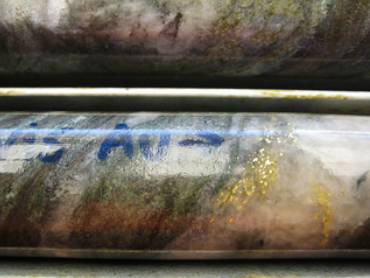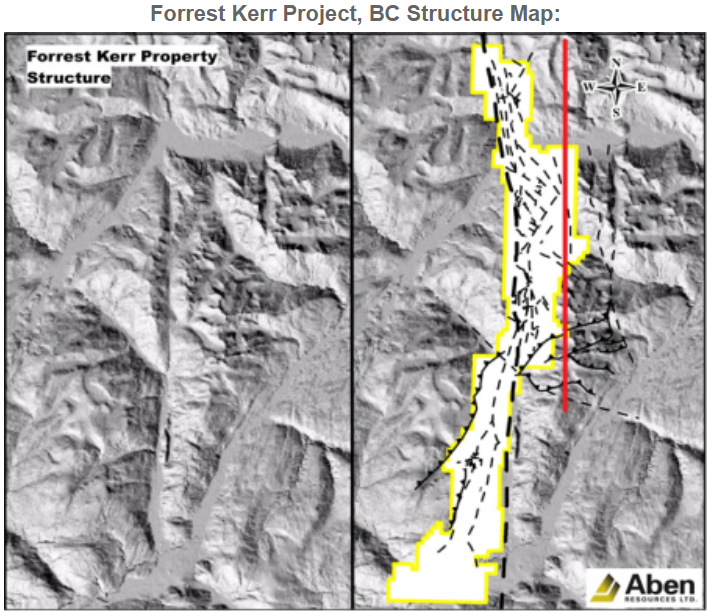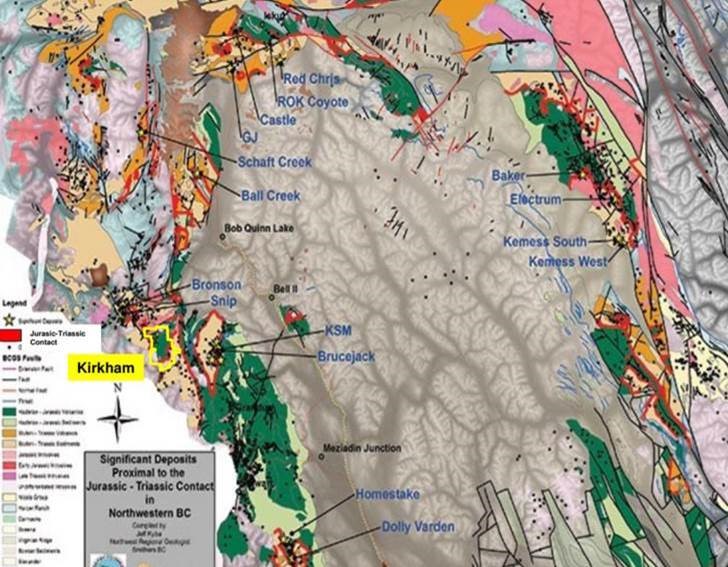
Rick Mills – “Aben Resources: Mines are Built Not Found”

Exploration is a hunt for minerals. If it was as easy as flying a helicopter survey, taking a few soil samples, and then punching in some corresponding holes, everyone would be successful at it. But it doesn’t work that way, the earth guards her secrets closely.
Even with the best geos, and the most advanced tools, exploration is still about proving theories, sometimes getting it right, more often, getting it wrong. It’s like that children’s game of hide and seek, where the kid hiding keeps saying, “warmer” as the seeker gets closer. Getting it wrong is just as important as getting it right, because it means the explorer is able to rule out theories and zero in on proven scientific hypotheses.
It’s geo-chemical and geo-physical studies combined with ground-based, direct observation, what geologists see with boots and hammers, essentially old-fashioned picking and turning over rocks, that leads to a successful drill program. A good lesson for gold explorers is that while “the truth machine” (drill) reveals all, in-the-field exploration, and proper interpretation of results makes for a successful exploration program.

And success, which in our business usually means high-grade assays, doesn’t often happen all at once, or continuously. The first drill season may reveal some excellent holes, the next season not so much, but important information was gleaned nonetheless. It’s all about creating models, testing them, discarding those that don’t work, and plodding along, relentlessly, not giving up.
As we near the end of the exploration season in the Golden Triangle of northwestern British Columbia, this is what we have to keep in mind as Aben Resources (TSX-V:ABN) keeps plugging away at its Forrest Kerr property.
The latest assay results from the holes drilled so far this summer means Aben is that much closer to understanding the structure of the ground it hopes to one day develop into a mine.
High expectations
Aben planned an initial 5,000m of drilling to follow up on last year’s expansion of the North Boundary Zone. As of time of writing, Aben is in the Forrest Zone finishing up the last few holes of a 10,000m program – at the time of writing 8,000m over 21 holes have been drilled.
The company had the opportunity to execute on a number of targets thanks to the authorization of 45 new drill pad locations versus just nine in 2018, which limited the amount, and angle, of drilling.
Considering that the last two exploration seasons both saw early success, within the first few holes drilled, expectations were high for Aben.
Last summer Aben hit a discovery hole early in the drilling season, by positioning the drill 35m northwest of the three 2017 holes (the North Boundary Zone) to investigate the possibility of mineralization at depth.
Featuring four high-grade zones all within 190 meters downhole, the jewelry-box-style mineralization assayed at an impressive 331 g/t over 1.0m, within a broader zone of 38.7 g/t over 10m. Other results from the discovery hole included 22.0 g/t gold and 22.4 g/t silver over 4.0m, 4.0 g/t silver over 13.0m, and 8.2 g/t gold with 1.4 g/t silver over 6.0m.
Until 2019, drilling at Aben targeted near-surface, high-grade gold and copper mineralization. That yielded some nice intersections, and was backed by the market with two separate stock runs for ABN in 2017 and 2018.
Aben’s 50-kilometer-long Forrest Kerr project runs beside and transects the Kerr fault, which acts as a major geological “engine” for the whole region, giving Aben tremendous discovery upside due to the amount of geological activity in the area.
The fact that the Kerr fault – a 40km region trend – transects Forrest Kerr is important, because it divides the Mesozoic stratigraphy (rock layers) to the east from the older Paleozoic stratigraphy to the west. The fault acts as a conduit for the hydrothermal fluids that rushed towards the surface due to volcanic activity.

Black line is Kerr Fault. Red line is the Stuhini-Hazelton group stratigraphic contact

Red Line in above picture is the Stuhini-Hazelton group stratigraphic contact
By: Lesley Stokes May 6, 2015 Northern Miner – Volume 101 Number 13 May 11 – 17, 2015 VANCOUVER — Geologists Jeff Kyba and Joanne Nelson from the B.C. Geological Survey may have unlocked the secret to world-class porphyry- and intrusion-related gold-copper deposits in northwestern B.C. They’ve discovered that most of the major deposits in the region occur within 2 km of a regional stratigraphic contact, and according to Kyba, there are lithological and structural clues to narrow that window even more. “The contact represents a period in earth’s history when a lot of deposits in B.C. were forming,” Kyba says during an interview with The Northern Miner. “But no one really knows what controlled their emplacement and where best to look. We’re trying to answer that question, and so far the results are exciting.” Northwest B.C. contains the remnants of a much larger, ancient volcanic arc — similar to the present-day Philippines — called the Stikine terrane. Between 220 and 175 million years ago, subduction and volcanism along the arc promoted the emplacement of worldclass deposits such as KSM, Brucejack, Eskay Creek, SchaftCreek and Red Chris — to name a few. But during the Cretaceous period, starting 144 million years ago, the metal-rich arc was compressed to nearly half its length as the margin of western North America collided with other terranes. The deformation was so intense that it obliterated most structural clues related to the main mineralizing event, making it difficult for explorers to locate the deposits. “The rocks here are much older than those in the Philippines or Indonesia, so they’ve been banged up quite a bit,” he says. “But just because the geology is more complex, doesn’t mean the deposits aren’t there.”
“Over the past five years, the northwest Stikine has built its momentum towards becoming the world’s next big mineral province,” he says. “People are recognizing that these deposits have high-grade roots and big extensions they never thought were there.” Kyba and Nelson started their investigations at the KSM and Brucejack copper-gold camp, where Pretium geologists were finding evidence for an old tectonic event that influenced mineralization. What they found was a unique package of basal conglomerates and turbidites along the Stuhini-Hazelton group stratigraphic contact. “To a geologist, these rocks indicate a hiatus in ancient volcanism and an increase in earthquake activity,” he explains.
“The land was uplifted along faults, and near its edges, the rocks were eroded and deposited into the basin below.” Kyba believes this tectonism provided the framework for metal-rich fluids and intrusions to migrate along when volcanism resumed during Hazelton time…Kyba mentions he has an “open-door” policy on the data he uses, and offers explorers a geological map that highlights the prospective contact as a thick, red line.“If you’re near that red line, and there’s a clastic sequence coupled with large-scale faults, then you might be in the neighbourhood of B.C.’s next big deposit,” he says. “And knowing that is a big game changer for explorers in the region, because it’ll get them closer to making a discovery.”
In May an airborne magnetic survey was run across the entire Boundary Zone, prior to drilling. The survey was aimed at gleaning more information about Forrest Kerr’s large, complicated structures, through drill testing.
Notably, Aben is drilling less holes than the 40+ originally intended, about 25, in order to go deeper into the anomalies that have been identified. The company says the mineralized structures correlate well with the survey’s magnetic highs.

Upper yellow mark is North Boundary Zone. Lower yellow mark is Southern Boundary Zone
Moving south
One of the most important targets Aben management had in mind was an area about 300m south of the North Boundary Zone.
This year’s drills followed up a high-grade hole encountered by Noranda way back in 1991, featuring an impressive 326.0 g/t gold.
Hole FK19-52 set up 50m south of the Noranda hole returned 2.22 g/t gold, 2.39 g/t silver and 3050 ppm copper, over 16m. Two 1m high-grade intervals of 19.85 g/t Au, 9.10 g/t Ag, 6810 ppm Cu and 11.30 g/t Au, 8.70 g/t Ag & 14900 ppm Cu were also cut from the core.
“One of the most important things we’re following is the geochem alteration which is really good,” Pettit told AOTH over the phone on Friday.
The company is now operating under the theory that, moving south down the drainage from North Boundary, the mineralization changes from predominantly sericite – a gold pathfinder mineral – to quartz-sericite-potassic alteration (an alteration is defined as a natural process that alter a rock’s chemistry, especially movement of hydrothermal fluids.)
Heat-seeking
A Ph.D geologist with expertise in porphyries concurs with Aben that this type of alteration is characteristic of a heat source that mineralized the Forrest Kerr property in several iterations – variable over short distances and hosted in a variety of alteration regimes including quartz-sericite-pyritehematite-chlorite.
The mystery still to be solved is identifying the porphyry, if that’s what it is, or it could be a large hydrothermal system, that carried the mineralization up towards surface during periods of volcanic activity millions of years ago.
To try and solve the mystery, Aben has been drilling southward from NBZ for about a kilometer. So far 17 holes have been drilled in that area, with assay results still to come. Aben will know it’s getting closer, if the mineralization starts showing more potassium than quartz or sericite.
“Were vectoring, using the chemical analysis and trying to vector into a point that should put us into a relatively small area we can test,” Pettit said.
Also in the assay hopper are results from holes drilled into the South Boundary Zone, where broad intercepts of gold-copper-silver-zinc mineralization were found in quartz veins last summer. The Forrest Zone about 12 kilometers to the south of North Boundary is currently being drilled. Soil samples taken from the north side of a mineralized outcrop are high-grade, so drills are piercing through the anomaly and its flanks.
Once Aben completed drilling at the Forrest Kerr Zone, it will have finished its $3 million exploration spending commitment that will earn it a 100% interest in the entire Forrest Kerr project.
Analogies
Clearly, Aben Resources is knee-deep in mineralization at Forrest Kerr. Two zones stand out as most prospective – North Boundary and the “Noranda Hole Zone” for lack of a better term. We know from geochemical and geophysical signatures, and two diamond drill campaigns, that there are alterations hidden beneath the steep terrain. We have a pretty good idea what the pieces of this puzzle are, but we aren’t yet sure how they “hang together” in a deposit.
Here’s the thing: Many very good mines that have reached the same stage Aben is in now, wherein mineralization has been found all over the property, but not yet in a form that delineates a resource, might not have been, if it weren’t for the perseverance of their discoverers. A couple of examples demonstrates this point:
Hemlo’s Giant Gold Mine in Ontario and the Eskay Creek Mine to the east of Forrest Kerr.
These mines demonstrate that sometimes you need to drill many holes before your project hosts a deposit – up to 100, or more – let alone your deposit becoming an economic producer.
Hemlo
Now owned by Barrick Gold, Hemlo’s Williams Mine is an underground and open-pit operation located about 350 km east of Thunder Bay, ON. Operating continuously for over 30 years, the mine has produced 21 million ounces of gold.
However this monster of a mine wouldn’t have been developed if it hadn’t been for the confidence of renowned Vancouver stock promoter Murray Pezim and a geologist named David Bell.
Although many prospectors and geologists staked claims and mining companies worked the ground in search of gold, no one was able to find anything significant. That’s because they were searching for quartz veins, where gold is often found. The gold that was unearthed was either not high-grade enough, or invisible to the eye but disseminated, in much the same way as Carlin-style gold in Nevada.
Most gave up, except for Don McKinnon and John Larche, two scrappy prospectors who began exploring the area when they staked claims in 1979. Republic of Mining describes what happened next:
After pounding on the doors of big exploration companies without any results, the two men met David Bell. An independent geologist who had had an eye on the Hemlo area for some time, Bell was eager to sink his drill into the claims staked by McKinnon and Larche. Bell had a theory that no one considered before, namely, that within the Hemlo area there was no quartz rock. According to Bell, the reason for this was due to the fact that the gold was scattered throughout volcanic sediment in wide and fine amounts–similar to the deposits in some of the richest goldfields in Africa.
Bell suggested the men look for a “junior.” A junior provides enough money for exploration in the hope that a major mining company will eventually take over the entire operation and give the prospectors a share of the profits. Bell soon found Vancouver businessman Murray “The Pez” Pezim. Pezim told Bell he could raise enough money for exploration through a junior called Corona Resources. For a negligible amount of cash, shares of stock, and a 1.5 percent royalty on every ounce of smelted gold for each of them, Larche and McKinnon gave up their claims at Hemlo to Corona Resources.
In January of 1981, Bell started drilling his first hole near the Trans-Canada Highway. Unable to find high grade gold-bearing material even after 70 holes, he continued drilling with Pezim’s encouragement. Turning toward the southwest and away from the highway, Bell drilled at different depths and tried different angles. Finally, on hole 76 at an angle of 50 degrees and a depth of 336.5 feet, Bell found a sample that graded .29 ounces of gold per ton. On May 7, 1981, Bell had made one of the most important discoveries in the history of North American mining.
Our point is, it took 75 holes at a cost of $1.5 million – a lot of money in those days – for Hemlo’s discoverers to successfully find a mine. No “get rich quick” sequence of events here.
The Hemlo deposit is interpreted to be a porphyry-style deposit. It is approximately 3km long by 2km deep and averages only 20m wide with a very small surface expression.
Eskay Creek
Although exploration dated back to the 1930s, it wasn’t until 1988 that two tiny juniors, Stikine Resources and Calpine Resources, hit the hole they needed to advance Eskay Creek: 27.2 g/t gold and 30.2 g/t silver over a lengthy 208m.
In fact the Northern Miner points out it was Calpine’s first discovery on the property that prompted its then-President, Murray Pezim, to “pull out all the stops and keep drilling despite one of the coldest winters in British Columbia history.”
Drills at the 21 Zone hit a discovery hole that cut 96.5 feet grading 0.752 oz gold per ton including 52.5 feet of 1.33 oz gold, uncut.
By the end of the 1988 season, Calpine had established a significant body of moderate to high grade gold mineralization in association with antimony and arsenic. Calpine’s partner, Stikine Resources, estimated this open pittable reserve to be about 3.0 million tons grading 0.25 oz gold.
Although Calpine’s discovery was noticed by the market, investors turned off when the remoteness of the region was pointed out, plus uncertainties over the metallurgy.
Pezim though wouldn’t relent, and the joint-venture partners decided to drill further into the 21 Zone, thanks to a $7 million exploration proposal.
Here’s the Miner again:
The rest, as they say, is history. Calpine’s step-out drilling this summer intersected a number of spectacular intervals, particularly hole 89-109 which averaged 0.875 oz gold and 0.97 oz silver over 682.2 ft.
It should be noted, however, that the hole was “carried” by a 62.3 ft interval grading 7.765 oz gold (uncut) and 1.35 oz silver.
By the end of September, Calpine had outlined three zones of mineralization collectively known as the 21 zone for a minimum strike length of 4,429 ft.
Former ‘Resource Opportunities’ newsletter Editor/ Publisher Lawrence Roulston hints strongly that money troubles could have easily sunk the project if it weren’t for Pezim and his deep-pocketed contacts:
With a strong financial backer, Calpine was able to carry out a comprehensive exploration program. They drilled more than 100 holes that were geologically encouraging, but which would not have attracted the attention of most investors. It was hole number 109 that convinced investors of the significance of the Eskay Creek discovery. That hole, one of the most impressive drill holes of all time, encountered an extraordinary 208 meters that assayed 27 grams per tonne gold and 30 g/t silver.
The gold-rich massive sulfide deposit would go on to become Canada’s highest grade gold mine and the world’s fifth largest silver producer, cranking out over 3 million ounces of gold and 160 million ounces of silver. Much of the bonanza-grade gold was hosted, and selectively mined, in the contact mudstone.
Conclusion
“It took 76 drill holes before Hemlo even began to be taken seriously, and 109 holes before Eskay Creek became widely accepted as a truly significant discovery”, reads a company history of Eskay Creek.
The analogies here with Aben are instructive. High-grade results always bring investors into the market and bid up the stock price, but smart shareholders know how to spot a company creating value through meticulous and constant testing of theories that point explorationists in the right direction. Mines are not found, they are built on hard work and determination.
Aben Resources Inc
TSX-V:ABN Cdn$0.11 2019.09.20
Shares Outstanding 116,672,367m
Market cap Cdn$12.83m
ABN website
*****
Richard (Rick) Mills
Ahead of the Herd Twitter
Legal Notice / Disclaimer
Ahead of the Herd newsletter, aheadoftheherd.com, hereafter known as AOTH.
Please read the entire Disclaimer carefully before you use this website or read the newsletter. If you do not agree to all the AOTH/Richard Mills Disclaimer, do not access/read this website/newsletter/article, or any of its pages. By reading/using this AOTH/Richard Mills website/newsletter/article, and whether or not you actually read this Disclaimer, you are deemed to have accepted it.
Any AOTH/Richard Mills document is not, and should not be, construed as an offer to sell or the solicitation of an offer to purchase or subscribe for any investment.
AOTH/Richard Mills has based this document on information obtained from sources he believes to be reliable but which has not been independently verified. AOTH/Richard Mills makes no guarantee, representation or warranty and accepts no responsibility or liability as to its accuracy or completeness. Expressions of opinion are those of AOTH/Richard Mills only and are subject to change without notice. AOTH/Richard Mills assumes no warranty, liability or guarantee for the current relevance, correctness or completeness of any information provided within this Report and will not be held liable for the consequence of reliance upon any opinion or statement contained herein or any omission. Furthermore, AOTH/Richard Mills assumes no liability for any direct or indirect loss or damage or, in particular, for lost profit, which you may incur as a result of the use and existence of the information provided within this AOTH/Richard Mills Report.
AOTH/Richard Mills is not a registered broker/financial advisor and does not hold any licenses. These are solely personal thoughts and opinions about finance and/or investments – no information posted on this site is to be considered investment advice or a recommendation to do anything involving finance or money aside from performing your own due diligence and consulting with your personal registered broker/financial advisor. You agree that by reading AOTH/Richard Mills articles, you are acting at your OWN RISK. In no event should AOTH/Richard Mills liable for any direct or indirect trading losses caused by any information contained in AOTH/Richard Mills articles. Information in AOTH/Richard Mills articles is not an offer to sell or a solicitation of an offer to buy any security. AOTH/Richard Mills is not suggesting the transacting of any financial instruments but does suggest consulting your own registered broker/financial advisor with regards to any such transactions
Richard owns shares of Aben Resources and ABN is an advertiser on Richards site aheadoftheherd.com
MORE or "UNCATEGORIZED"
PPX Mining Announces Closing Of $1.35 Million Private Placement
PPX Mining Corp. is pleased to announce that it has closed its fu... READ MORE
Elevation Gold Reports Financial Results for Year Ended December 31, 2023, including $66.4M in Total Revenue
Elevation Gold Mining Corporation (TSX-V: ELVT) (OTCQB: EVGDF) i... READ MORE
Reunion Gold Announces the Signing of a Mineral Agreement With the Government of Guyana for Its Oko West Project
Reunion Gold Corporation (TSX-V: RGD; OTCQX: RGDFF) is pleased to announ... READ MORE
Drilling Confirms 4 km of Favourable Corridor at Lynx Gold Trend
Puma Exploration Inc. (TSX-V: PUMA) (OTCQB: PUMXF) is thrilled to... READ MORE
Grid Metals Intersects 7 m at 1.28% Li2O at over 125 m Below the Previously Deepest Drill Holes at Donner Lake; Provides Project Update
Grid Metals Corp. (TSX-V:GRDM) (OTCQB:MSMGF) is pleased to announ... READ MORE










